Selective Detection of Nitrogen-Containing Compound Gases
Abstract
1. Introduction
2. Materials and Methods
2.1. Synthesis
2.1.1. AZO NPs
2.1.2. Pt-AZO NPs
2.1.3. Pt-WO3 and Au-WO3 Thin Films
2.1.4. N-Doped Graphene
2.1.5. Summary of Sensing Materials
2.2. Characterization
2.3. Device Fabrication
2.4. Gas Sensing Measurement
3. Results and Discussion
4. Conclusions
Author Contributions
Funding
Conflicts of Interest
References
- Timmer, B.; Olthuis, W.; van den Berg, A. Ammonia sensors and their applications—A review. Sens. Actuators B Chem. 2005, 107, 666–677. [Google Scholar] [CrossRef]
- Lippmann, M.; Schlesinger, R.B. Chemical Contamination in the Human Environment; Oxford University Press: New York, NY, USA, 1979. [Google Scholar]
- Ringo, E.; Stenberg, E.; Stroem, A.R. Amino acid and lactate catabolism in trimethylamine oxide respiration of Alteromonas putrefaciens NCMS 1735. Appl. Environ. Microbiol. 1984, 47, 1084–1089. [Google Scholar] [PubMed]
- Sadok, S.; Uglow, R.F.; Haswell, S.J. Determination of trimethylamine in fish by flow injection analysis. Anal. Chim. Acta 1996, 321, 69–74. [Google Scholar] [CrossRef]
- Egashira, M.; Shimizu, Y.; Takao, Y. Trimethylamine sensor based semiconductive metal oxides for detection of fish freshness. Sens. Actuators B Chem. 1990, 1, 108–112. [Google Scholar] [CrossRef]
- Moula, G.; Bose, M.; Sarkar, S. Replica of a fishy enzyme: Structure—Function analogue of trimethylamine-N-oxide reductase. Inorg. Chem. 2013, 52, 5316–5317. [Google Scholar] [CrossRef] [PubMed]
- Wei, P.H.; Li, G.B.; Zhao, S.Y.; Chen, L.R. Gas-sensing properties of Th/SnO2 thin film gas sensor to trimethylamine. J. Electrochem. Soc. 1999, 146, 3536–3537. [Google Scholar] [CrossRef]
- Triethylamine, Wikimedia Foundation Inc. Available online: https://en.wikipedia.org/wiki/Triethylamine#cite_note-7 (accessed on 9 August 2019).
- Perkins, F.K.; Friedman, A.L.; Cobas, E.; Campbell, P.M.; Jernigan, G.G.; Jonker, B.T. Chemical vapor sensing with monolayer MoS2. Nano Lett. 2013, 13, 668–673. [Google Scholar] [CrossRef]
- Fonger, G.C. Hazardous Substances Data Bank (HSDB) as a source of environmental fate information on chemicals. Toxicology 1995, 103, 137–145. [Google Scholar] [CrossRef]
- Your Best Option for Treating any Condition. Available online: http://www.kansashealthsystem.com/~/media/Imported/kumed/documents/nitricoxide.ashx?la=en (accessed on 9 August 2019).
- Nitric Oxide Gas Detectors (NO Detectors). Available online: http://www.indsci.com/products/nitric-oxide/ (accessed on 9 August 2019).
- Shi, Y.; Xia, Y.F.; Lu, B.H.; Liu, N.; Zhang, L.; Li, S.J.; Li, W. Emission inventory and trends of NOx for China, 2000–2020. J. Zhejiang Univ. Sci. A 2014, 15, 454–464. [Google Scholar] [CrossRef]
- Atkinson, R. Atmospheric chemistry of VOCs and NOx. Atmos. Environ. 2000, 34, 2063–2101. [Google Scholar] [CrossRef]
- Wilkins, C.K.; Clausen, P.A.; Wolkoff, P.; Larsen, S.T.; Hammer, M.; Larsen, K.; Hansen, V.; Nielsen, G.D. Formation of strong airway irritants in mixtures of isoprene/ozone and isoprene/ozone/nitrogen dioxide. Environ. Health Perspect. 2001, 109, 937–941. [Google Scholar] [CrossRef] [PubMed]
- Nitrogen Oxides (Nitric Oxide, Nitrogen Dioxide, etc.). Available online: https://www.atsdr.cdc.gov/toxfaqs/tfacts175.pdf (accessed on 9 August 2019).
- Nitrogen Dioxide (NO2). Available online: http://www.environment.gov.au/protection/publications/factsheet-nitrogen-dioxide-no2 (accessed on 9 August 2019).
- Fahrländer, C.B.; Liebrich, U.A.; Schwartz, J.; Gnehm, H.P.; Rutishauser, M.; Wanner, H.U. Air pollution and respiratory symptoms in preschool children. Am. Rev. Respir. Dis. 1992, 145, 42–47. [Google Scholar] [CrossRef] [PubMed]
- Index of Chemical Names. 1988 OSHA PEL Project Documentation; The National Institute for Occupational Safety and Health (NIOSH): Cincinnati, OH, USA, 1988.
- Zou, Y.; Chen, S.; Sun, J.; Liu, J.; Che, Y.; Liu, X.; Zhang, J.; Yang, D. Highly efficient gas sensor using a hollow SnO2 microfiber for triethylamine detection. ACS Sens. 2017, 2, 897–902. [Google Scholar] [CrossRef] [PubMed]
- Guo, T.; Luo, Y.; Zhang, Y.; Lin, Y.H.; Nan, C.W. ZnO-NiO hetero-nanostructures as highly sensitive and selective triethylamine sensor. J. Appl. Phys. 2014, 116, 044309. [Google Scholar] [CrossRef]
- Ju, D.X.; Xu, H.Y.; Qiu, Z.W.; Zhang, Z.C.; Xu, Q.; Zhang, J.; Wang, J.Q.; Cao, B.Q. Near room temperature, fast-response, and highly sensitive triethylamine sensor assembled with Au-Loaded ZnO/SnO2 core–shell nanorods on flat alumina substrates. ACS Appl. Mater. Interfaces 2015, 7, 19163–19171. [Google Scholar] [CrossRef]
- Bai, S.; Ma, Y.; Luo, R.; Chen, A.; Li, D. Room temperature triethylamine sensing properties of polyaniline–WO3 nanocomposites with p–n heterojunctions. RSC Adv. 2016, 6, 2687–2694. [Google Scholar] [CrossRef]
- Yang, W.; Feng, L.; He, S.; Liu, L.; Liu, S. Density gradient strategy for preparation of broken In2O3 microtubes with remarkably selective detection of triethylamine vapor. ACS Appl. Mater. Interfaces 2018, 10, 27131–27140. [Google Scholar] [CrossRef]
- Xue, D.; Wang, Y.; Cao, J.; Zhang, Z. Hydrothermal Synthesis of CeO2-SnO2 Nanoflowers for Improving Triethylamine Gas Sensing Property. Nanomaterials 2018, 8, 1025. [Google Scholar] [CrossRef]
- Perillo, P.M.; Rodríguez, D.F. Low temperature trimethylamine flexible gas sensor based on TiO2 membrane nanotubes. J. Alloys Compd. 2016, 657, 765–769. [Google Scholar] [CrossRef]
- Zhu, S.; Liu, X.; Chen, Z.; Liu, C.; Feng, C.; Gu, J.; Liu, Q.; Zhang, D. Synthesis of Cu-doped WO3 materials with photonic structures for high performance sensors. J. Mater. Chem. 2010, 20, 9126–9132. [Google Scholar] [CrossRef]
- Li, H.Y.; Huang, L.; Wang, X.X.; Lee, C.S.; Yoon, J.W.; Zhou, J.; Guo, X.; Lee, J.H. Molybdenum trioxide nanopaper as a dual gas sensor for detecting trimethylamine and hydrogen sulfide. RSC Adv. 2017, 7, 3680–3685. [Google Scholar] [CrossRef]
- Cho, Y.H.; Kang, Y.C.; Lee, J.H. Highly selective and sensitive detection of trimethylamine using WO3 hollow spheres prepared by ultrasonic spray pyrolysis. Sens. Actuators B Chem. 2013, 176, 971–977. [Google Scholar] [CrossRef]
- Cho, Y.H.; Ko, Y.N.; Kang, Y.C.; Kim, I.; Lee, J. Ultraselective and ultrasensitive detection of trimethylamine using MoO3 nanoplates prepared by ultrasonic spray pyrolysis. Sens. Actuators B Chem. 2014, 195, 189–196. [Google Scholar] [CrossRef]
- Zhang, W.H.; Zhang, W.D. Fabrication of SnO2−ZnO Nanocomposite Sensor for Selective Sensing of Trimethylamineand the Freshness of Fishes. Sens. Actuators B Chem. 2008, 134, 403–408. [Google Scholar] [CrossRef]
- Chu, X.; Zhou, S.; Zhang, W.; Shui, H. Trimethylamine sensing properties of nano-LaFeO3 prepared using solid-state reaction in the presence of PEG400. Mater. Sci. Eng. B 2009, 164, 65–69. [Google Scholar] [CrossRef]
- Dao, D.V.; Shibuya, K.; Bui, T.T.; Sugiyama, S. Micromachined NH3 gas sensor with ppb-level sensitivity based on WO3 nanoparticles thin film. Procedia Eng. 2011, 25, 1149–1152. [Google Scholar] [CrossRef]
- Arienzo, M.D.; Armelao, L.; Mari, C.M.; Polizzi, S.; Ruffo, R.; Scotti, R.; Morazzoni, F. Macroporous WO3 thin films active in NH3 sensing: Role of the hosted Cr isolated centers and Pt nanoclusters. J. Am. Chem. Soc. 2011, 133, 5296–5304. [Google Scholar] [CrossRef] [PubMed]
- Srivastava, V.; Jain, K. Highly sensitive NH3 sensor using Pt catalyzed silica coating over WO3 thick films. Sens. Actuators B Chem. 2008, 133, 46–52. [Google Scholar] [CrossRef]
- Maekawa, T.; Tamaki, J.; Miura, N.; Yamazoe, N. Gold-loaded tungsten oxide sensor for detection of ammonia in air. Chem. Lett. 1992, 4, 639–642. [Google Scholar] [CrossRef]
- Late, D.J.; Doneux, T.; Bougouma, M. Single-layer MoSe2 based NH3 gas sensor. Appl. Phys. Lett. 2014, 105, 233103. [Google Scholar] [CrossRef]
- Wu, H.; Ma, Z.; Lin, Z.; Song, H.; Yan, S.; Shi, Y. High-Sensitive Ammonia Sensors Based on Tin Monoxide Nanoshells. Nanomaterials 2019, 9, 388. [Google Scholar] [CrossRef]
- Rout, C.R.; Hegde, M.; Govindaraj, A.; Rao, C.N.R. Ammonia sensors based on metal oxide nanostructures. Nanotechnology 2007, 18, 205504. [Google Scholar] [CrossRef]
- Nguyen, L.Q.; Phan, P.Q.; Duong, H.N.; Nguyen, C.D.; Nguyen, L.H. Enhancement of NH3 gas sensitivity at room temperature by carbon nanotube-based sensor coated with Co nanoparticles. Sensors 2013, 13, 1754–1762. [Google Scholar] [CrossRef] [PubMed]
- Wang, Y.; Zhang, L.; Hu, N.; Wang, Y.; Zhang, Y.; Zhou, Z.; Liu, Y.; Shen, S.; Peng, C. Ammonia gas sensors based on chemically reduced graphene oxide sheets self-assembled on Au electrodes. Nanoscale Res. Lett. 2014, 9, 251. [Google Scholar] [CrossRef] [PubMed]
- Chen, L.; Tsang, S.C. Ag doped WO3-based powder sensor for the detection of NO gas in air. Sens. Actuators B Chem. 2003, 89, 68–75. [Google Scholar] [CrossRef]
- Penza, M.; Martucci, C.; Cassano, G. NOx gas sensing characteristics of WO3 thin films activated by noble metals (Pd, Pt, Au) layers. Sens. Actuators B Chem. 1998, 50, 52–59. [Google Scholar] [CrossRef]
- Wang, S.H.; Shen, C.Y.; Su, J.M.; Chang, S.W. A room temperature nitric oxide gas sensor based on a copper-ion-doped polyaniline/tungsten oxide nanocomposite. Sensors 2015, 15, 7084–7095. [Google Scholar] [CrossRef]
- Ho, K.C.; Tsou, Y.H. Chemiresistor-type NO gas sensor based on nickel phthalocyanine thin films. Sens. Actuators B Chem. 2001, 77, 253–259. [Google Scholar] [CrossRef]
- Tamaki, J.; Hashihin, T.; Uno, Y.; Da, D.V.; Sugiyama, S. Ultrahigh-sensitive WO3 nanosensor with interdigitated Au nano-electrode for NO2 detection. Sens. Actuators B Chem. 2008, 132, 234–238. [Google Scholar] [CrossRef]
- Zhang, C.; Debliquy, M.; Boudiba, A.; Liao, H.; Coddet, C. Sensing properties of atmospheric plasma-sprayed WO3 coating for sub-ppm NO2 detection. Sens. Actuators B Chem. 2010, 144, 280–288. [Google Scholar] [CrossRef]
- Xia, H.; Wang, Y.; Kong, F.; Wang, S.; Zhu, B.; Guo, X.; Zhang, J.; Wang, Y.; Wu, S. Au-doped WO3-based sensor for NO2 detection at low operating temperature. Sens. Actuators B Chem. 2008, 134, 133–139. [Google Scholar] [CrossRef]
- Fruhberger, B.; Stirling, N.; Grillo, F.G.; Ma, S.; Ruthven, D.; Lad, R.J.; Frederick, B.G. Detection and quantification of nitric oxide in human breath using a semiconducting oxide based chemiresistive microsensor. Sens. Actuators B Chem. 2001, 76, 226–234. [Google Scholar] [CrossRef]
- Pan, X.; Zhao, X.; Bermak, A.A.; Fan, Z. A humidity-insensitive NO2 gas sensor with high selectivity. IEEE Electron Device Lett. 2016, 37, 92–95. [Google Scholar] [CrossRef]
- Maeng, S.; Kim, S.W.; Lee, D.H.; Moon, S.E.; Kim, K.C.; Maiti, A. SnO2 nanoslab as NO2 sensor: Identification of the NO2 sensing mechanism on a SnO2 surface. ACS Appl. Mater. Interfaces 2014, 6, 357–363. [Google Scholar] [CrossRef] [PubMed]
- Novikov, S.; Lebedeva, N.; Satrapinski, A. Ultrasensitive NO2 gas sensor based on epitaxial graphene. J. Sens. 2015, 2015, 108581. [Google Scholar] [CrossRef]
- Kneer, J.; Wöllenstein, J.; Palzer, S. Manipulating the gas–surface interaction between copper(II) oxide and mono-nitrogen oxides using temperature. Sens. Actuators B Chem. 2016, 229, 57–62. [Google Scholar] [CrossRef]
- Yoo, R.; Li, D.; Rim, H.J.; Cho, S.; Lee, H.-S.; Lee, W. High sensitivity in Al-doped ZnO nanoparticles for detection of acetaldehyde. Sens. Actuators B Chem. 2018, 266, 883–888. [Google Scholar] [CrossRef]
- Koo, A.; Yoo, R.; Woo, S.P.; Lee, H.-S.; Lee, W. Enhanced acetone-sensing properties of Pt-decorated Al-doped ZnO nanoparticles. Sens. Actuators B Chem. 2019, 280, 109–119. [Google Scholar] [CrossRef]
- Choe, Y.-S. New gas sensing mechanism for SnO2 thin-film gas sensors fabricated by using dual ion beam sputtering. Sens. Actuators B Chem. 2001, 77, 200–208. [Google Scholar] [CrossRef]
- Cho, H.; Oh, I.; Kang, J.; Park, S.; Ku, B.; Park, M.; Kwak, S.; Khanra, P.; Lee, J.H.; Kim, M.J. Catalyst and doping methods for arc graphene. Nanotechnology 2014, 25, 445601. [Google Scholar] [CrossRef]
- Shimizu, Y.; Matsunaga, N.; Hyodo, T.; Egashira, M. Improvement of SO2 sensing properties of WO3 by noble metal loading. Sens. Actuators B Chem. 2001, 77, 35–40. [Google Scholar] [CrossRef]
- Itoh, T.; Nakashima, T.; Akamatsu, T.; Izu, N.; Shin, W. Nonanal gas sensing properties of platinum, palladium, and gold-loaded tin oxide VOCs sensors. Sens. Actuators B Chem. 2013, 187, 135–141. [Google Scholar] [CrossRef]
- Joshi, R.K.; Gomez, H.; Alvi, F.; Kumar, A. Graphene films and ribbons for sensing of O2, and 100 ppm of CO and NO2 in practical conditions. J. Phys. Chem. C 2010, 114, 6610–6613. [Google Scholar] [CrossRef]
- Lu, Y.F.; Lo, S.T.; Lin, J.C.; Zhang, W.; Lu, J.Y.; Liu, F.H.; Tseng, C.M.; Lee, Y.H.; Liang, C.T.; Li, L.J. Nitrogen-doped graphene sheets grown by chemical vapor deposition: Synthesis and influence of nitrogen impurities on carrier transport. ACS Nano 2013, 7, 6522–6532. [Google Scholar] [CrossRef] [PubMed]
- Usachov, D.; Vilkov, O.; Grüneis, A.; Haberer, D.; Fedorov, A.; Adamchuk, V.K.; Preobrajenski, A.B.; Dudin, P.; Barinov, A.; Oehzelt, M.; et al. Nitrogen-doped graphene: Efficient growth, structure, and electronic properties. Nano Lett. 2011, 11, 5401–5407. [Google Scholar] [CrossRef] [PubMed]
- Shaik, M.; Rao, V.K.; Gupta, M.; Murthy, K.S.R.C.; Jainc, R. Chemiresistive gas sensor for the sensitive detection of nitrogen dioxide based on nitrogen doped graphene nanosheets. RSC Adv. 2016, 6, 1527–1534. [Google Scholar] [CrossRef]
- Dai, J.; Yuan, J.; Giannozzi, P. Gas adsorption on graphene doped with B, N, Al, and S: A theoretical study. Appl. Phys. Lett. 2009, 95, 232105. [Google Scholar] [CrossRef]
- Jappor, H.R.; Khudair, S.A.M. Electronic properties of adsorption of CO, CO2, NH3, NO, NO2 and SO2 on nitrogen doped graphene for gas sensor applications. Sens. Lett. 2017, 15, 432–439. [Google Scholar] [CrossRef]
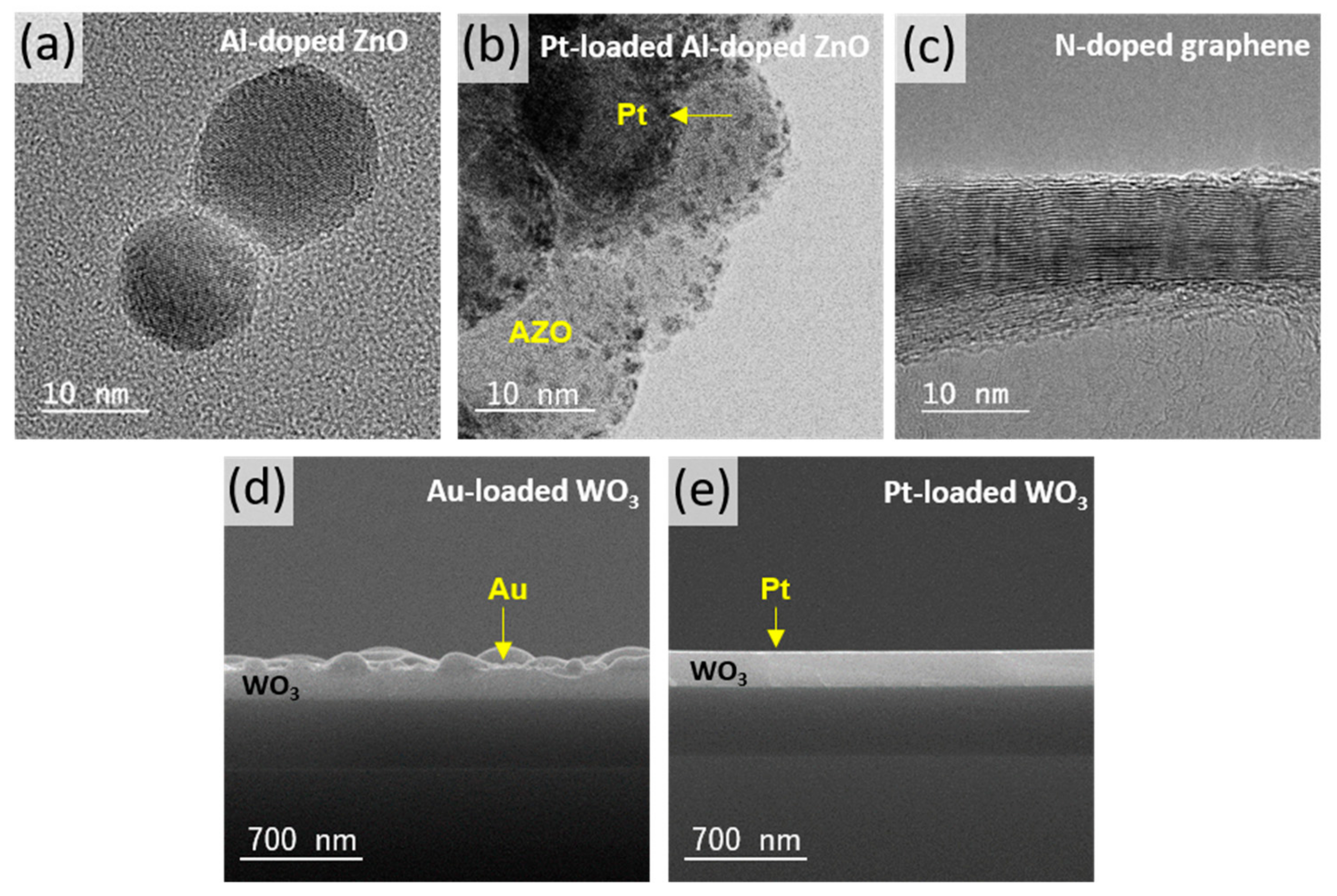
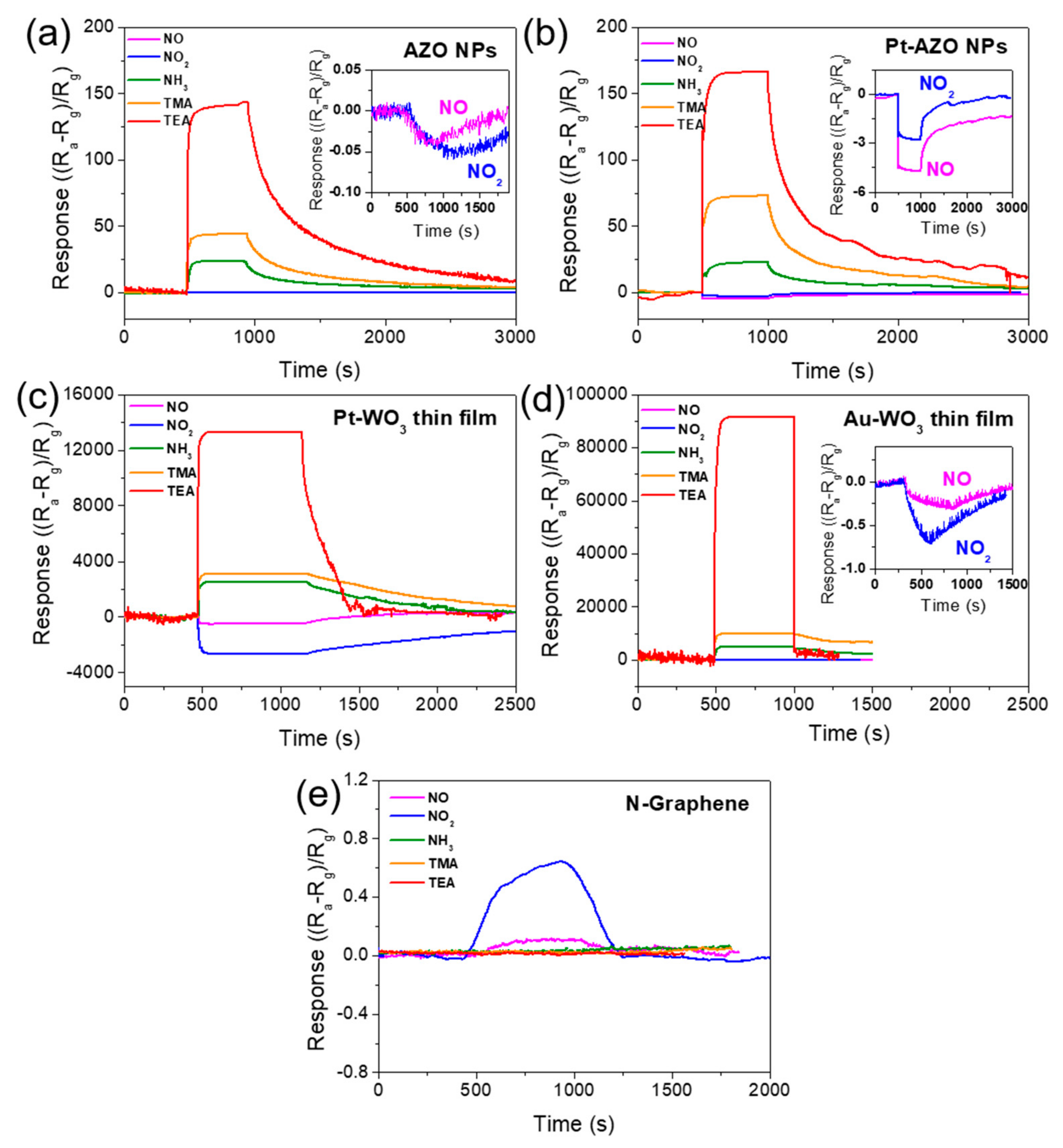
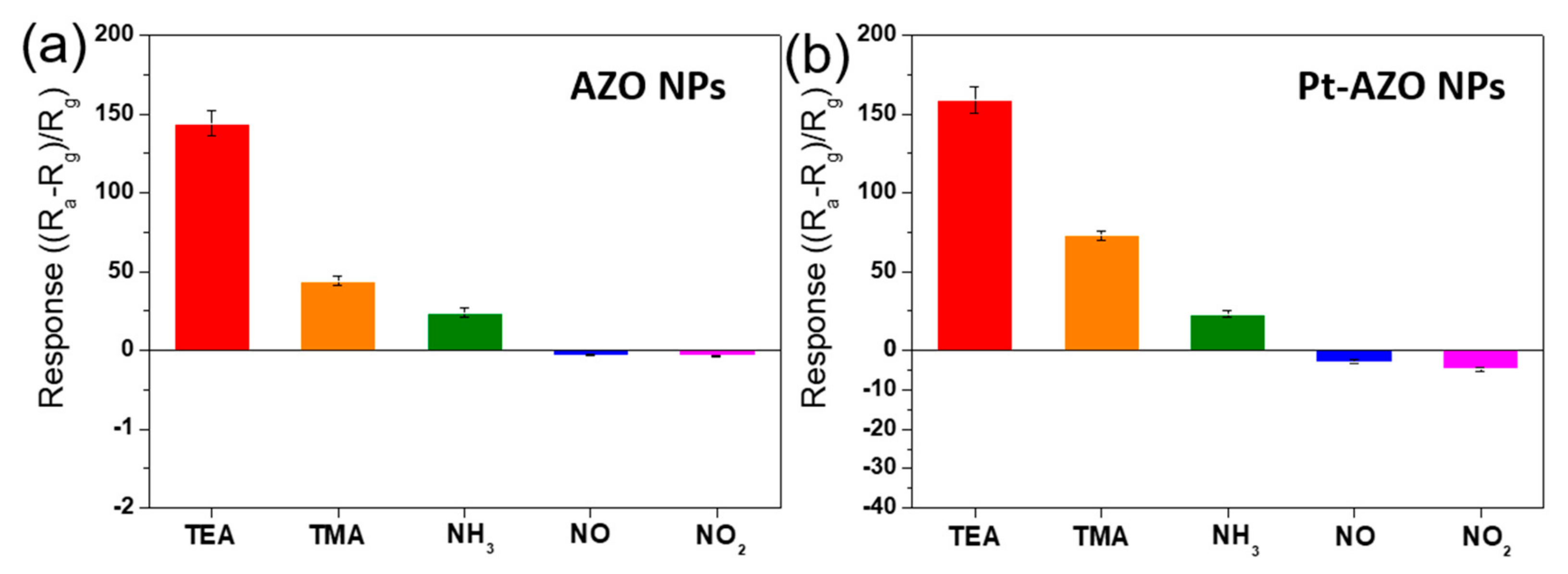
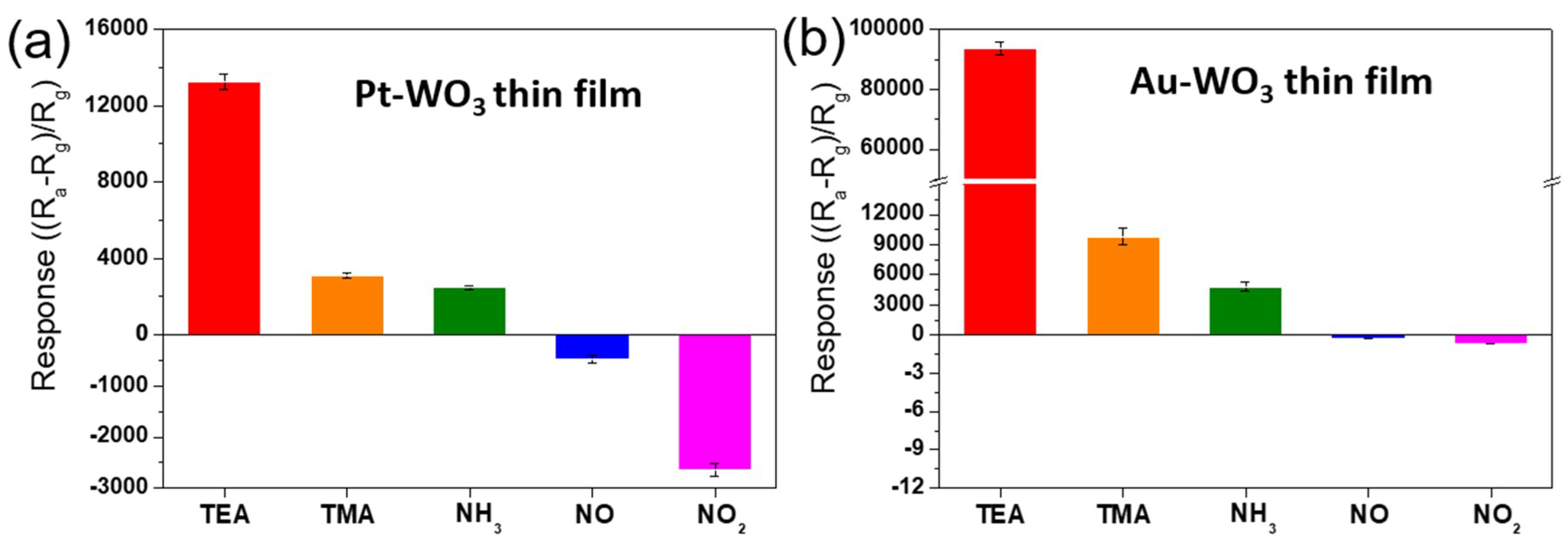
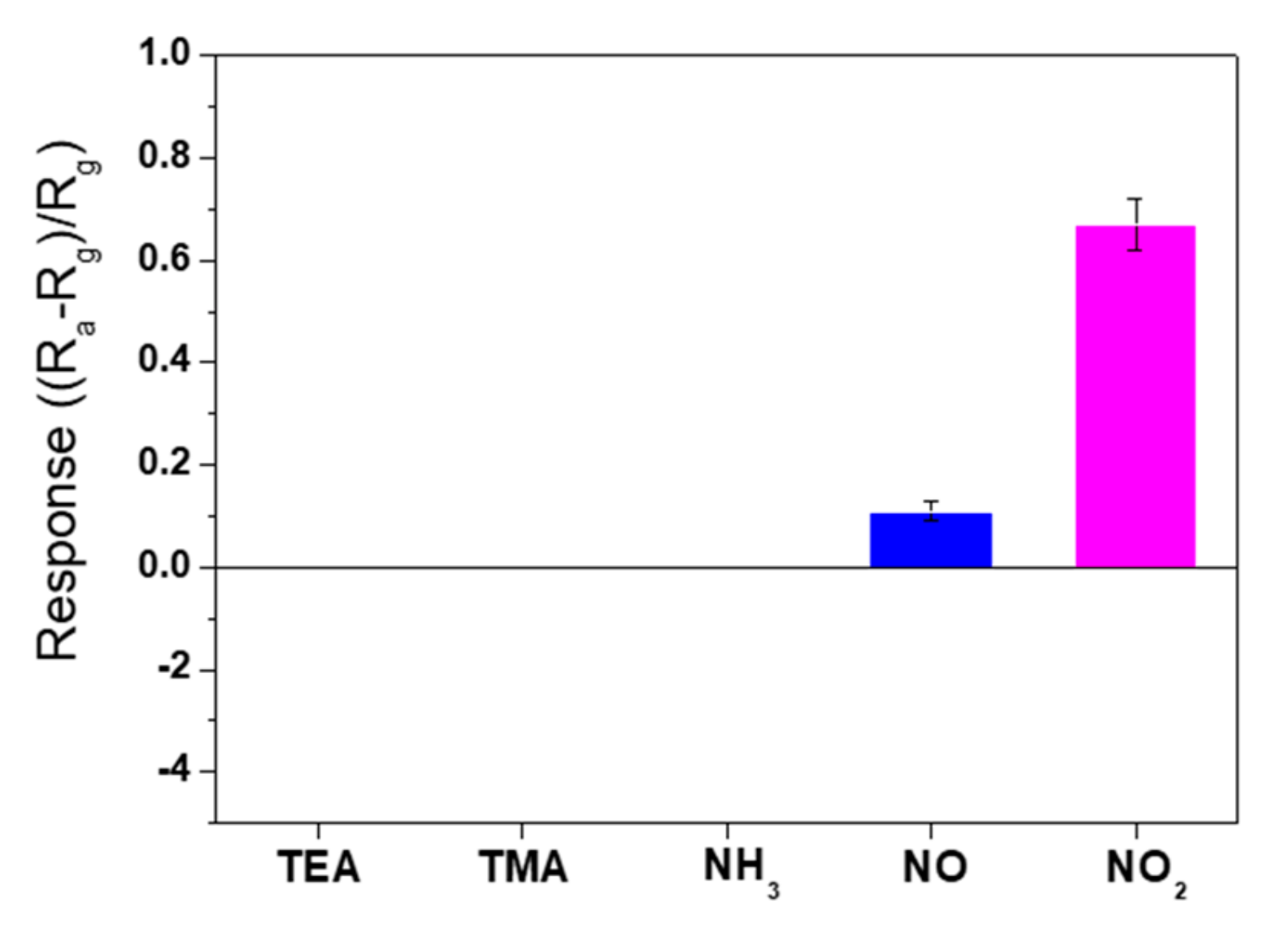
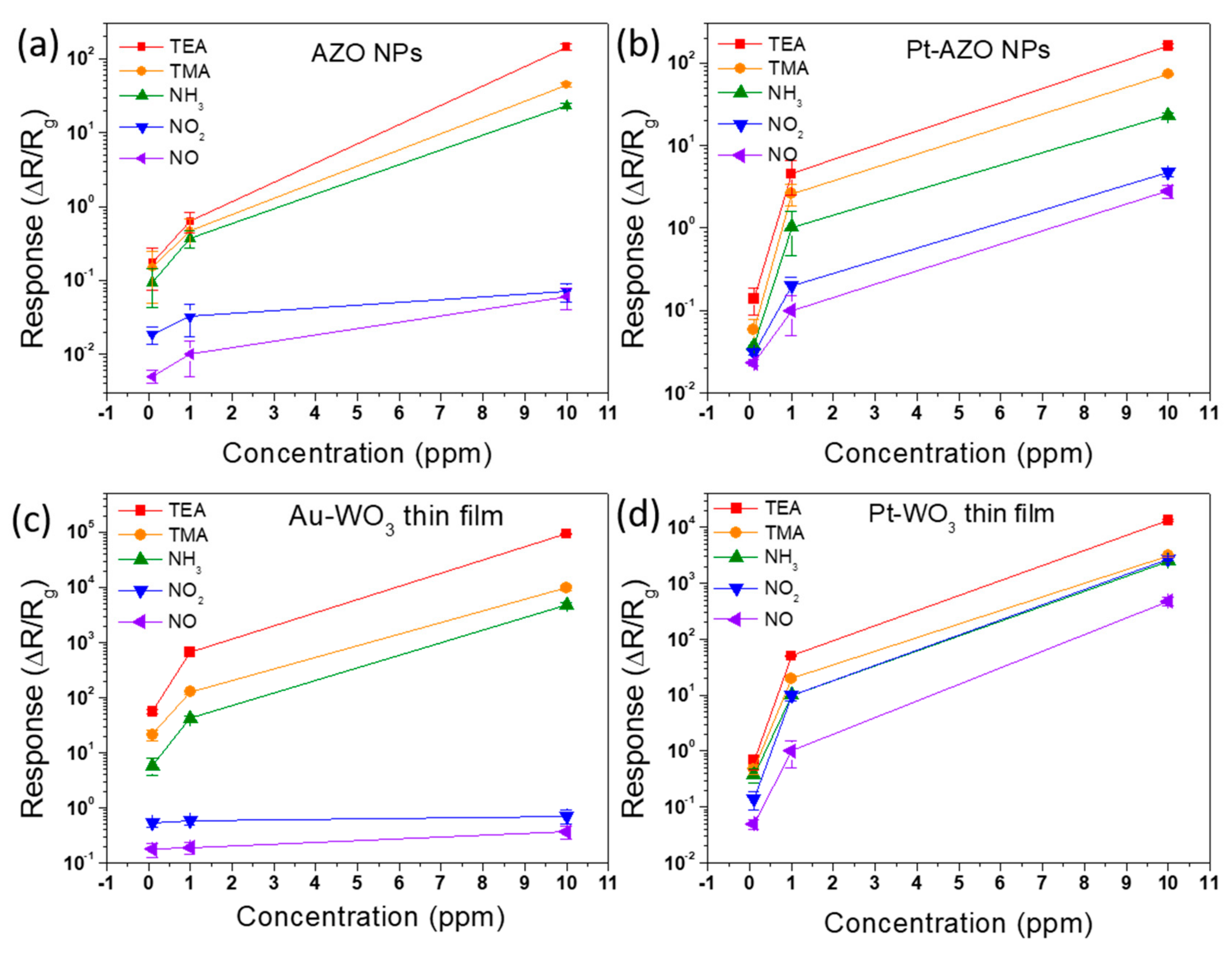
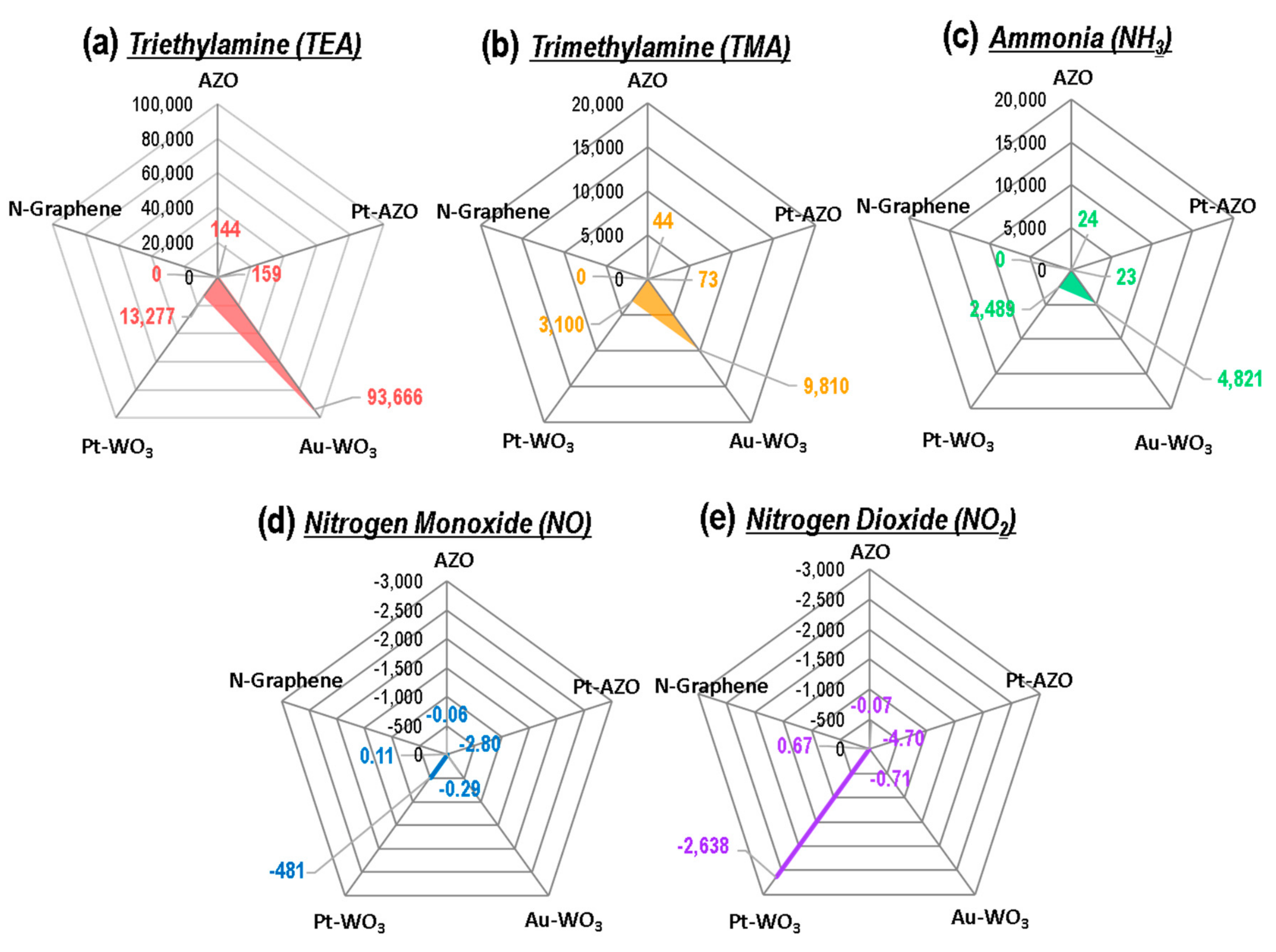
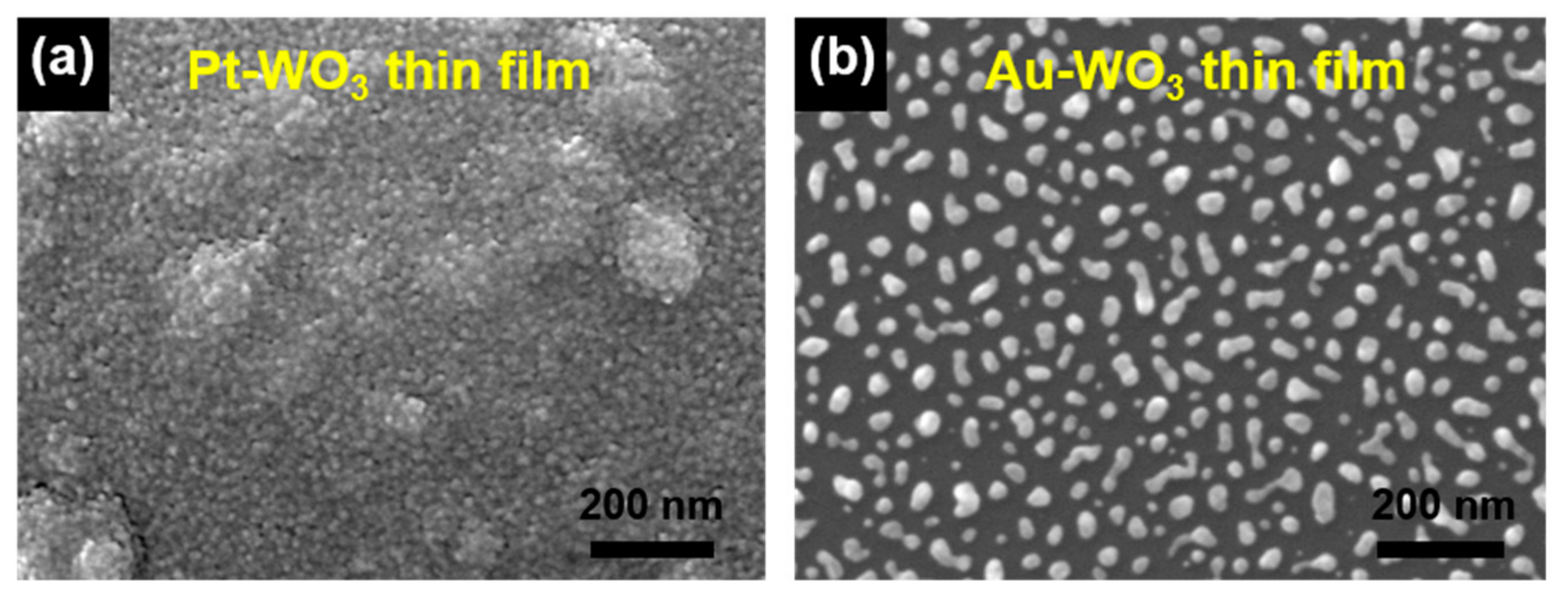
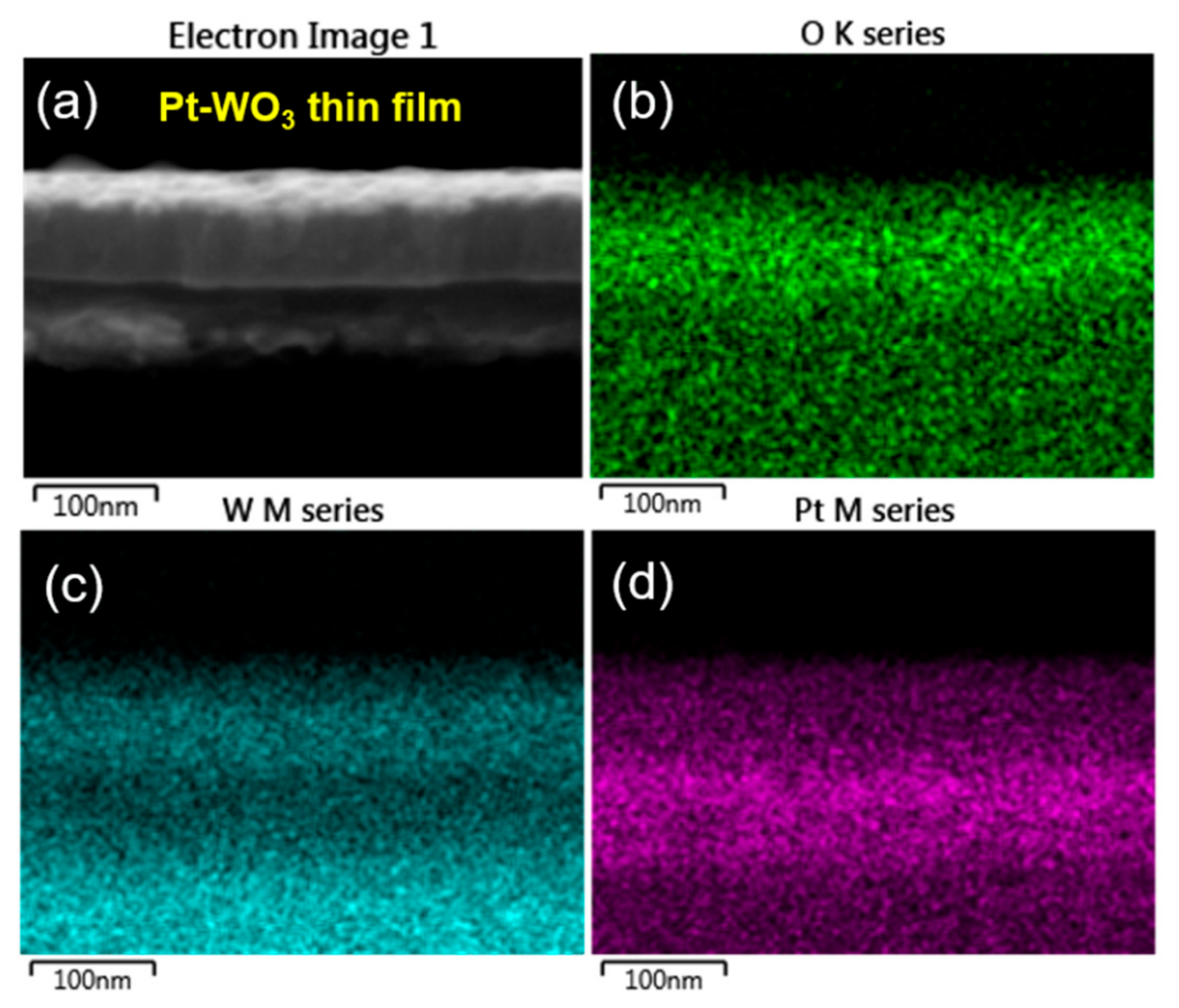
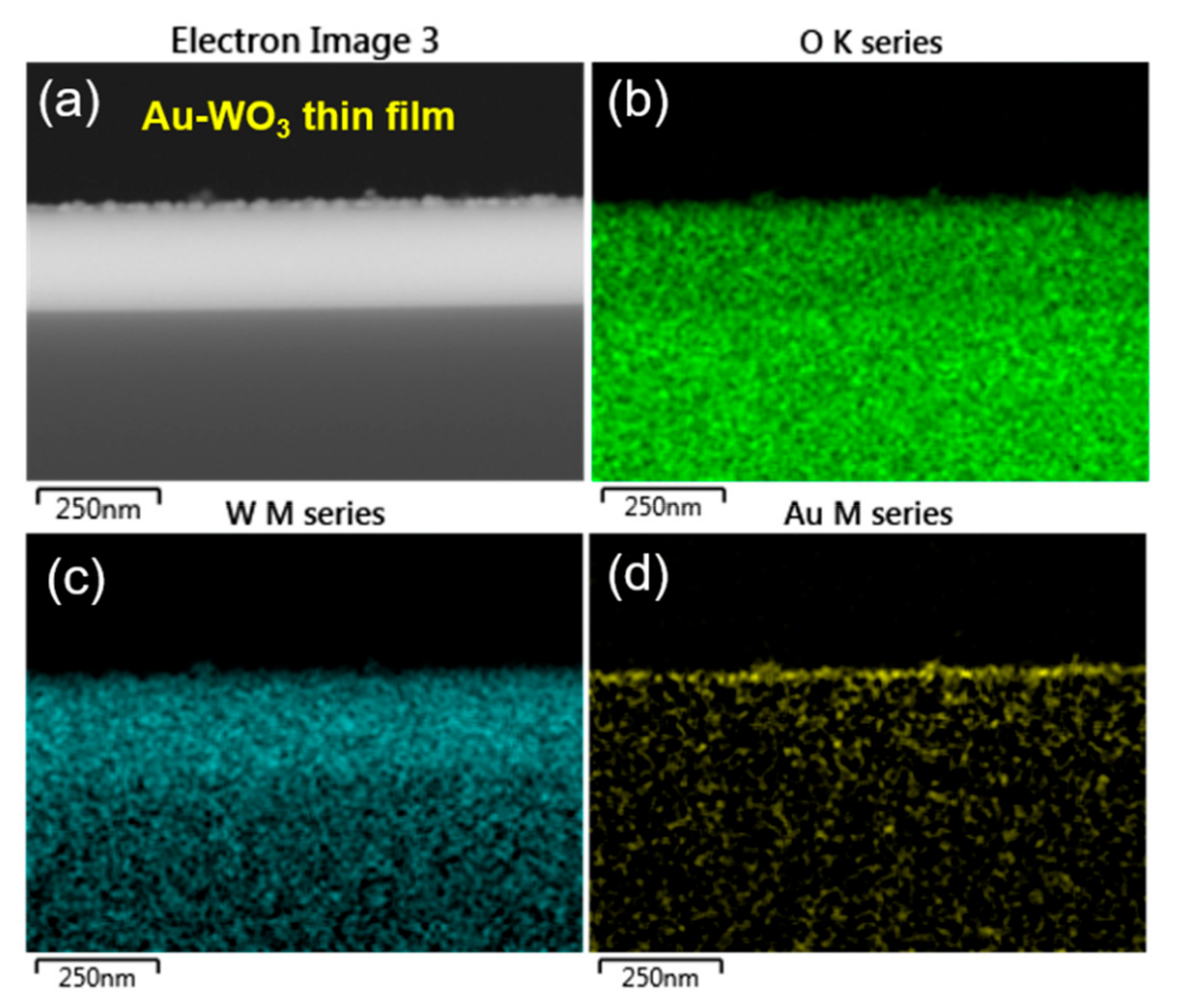
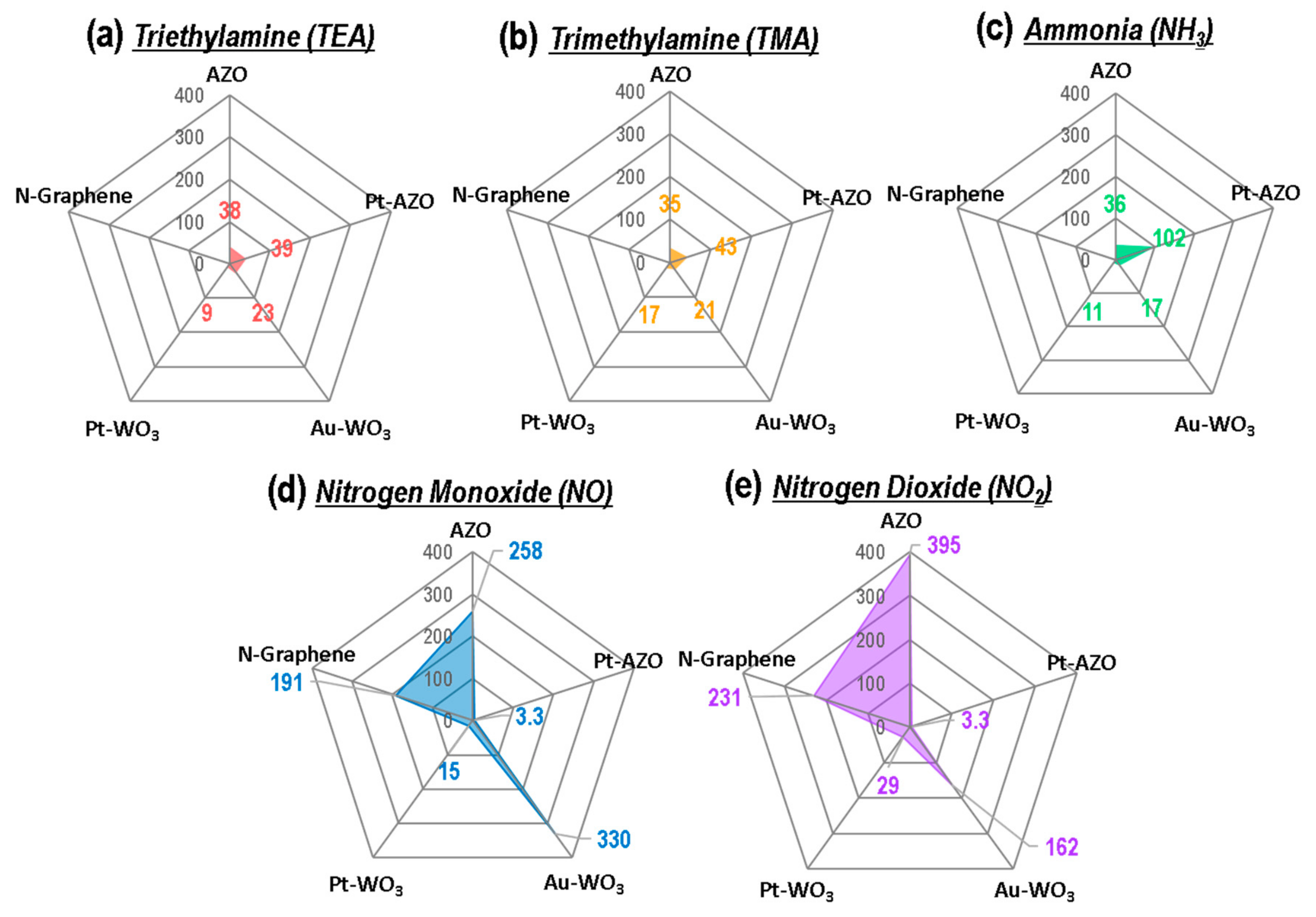
| Gas | Short-Term Exposure Limit (15 min, ppm) | Time Weighted Average (8 h, ppm) |
|---|---|---|
| NH3 | 50 | 35 |
| TMA | 15 | 10 |
| TEA | 25 | 15 |
| NO | - | 25 |
| NO2 | 5 | 3 |
| Sensing Materials | Fabrication Method | Specifications |
|---|---|---|
| AZO NPs | Hydrothermal synthesis | AZO NPs Size: 20–30 nm |
| Pt-AZO NPs | Hydrothermal synthesis + sputtering | AZO NPs size: 20–30 nm |
| Pt NPs size: 2–3 nm | ||
| Al doping: 1 at% | ||
| Pt-WO3 thin film | Dual ion beam sputtering | WO3 thickness: 200 nm |
| Pt thickness: 2 nm | ||
| Au-WO3 thin film | Dual ion beam sputtering | WO3 thickness: 200 nm |
| Au thickness: 2 nm | ||
| N-doped graphene | Arc discharge of graphite | N doping: 2 wt% |
| Gas | Sensing Materials | Operating Temperature [°C] | Concentration [ppm] | Response (R/Rg) | S * [ppm−1] | Ref. |
|---|---|---|---|---|---|---|
| TEA | Hollow SnO2 microfiber | 270 | 100 | 49.5 | 0.49 | [20] |
| ZnO-NiO hetero-nanostructures | 250 | 200 | 35 | 0.17 | [21] | |
| Au-Loaded ZnO/SnO2 Core-Shell Nanorods | 40 | 50 | 12.4 | 0.25 | [22] | |
| polyaniline-WO3 nanocomposites | 25 | 100 | 80 | 0.8 | [23] | |
| broken In2O3 microtubes | 300 | 100 | 72.5 | 0.72 | [24] | |
| CeO2-SnO2 Nanoflowers | 310 | 200 | 252.2 | 1.26 | [25] | |
| Al-doped ZnO (AZO) nanoparticles | 400 | 10 | 144 | 14.4 | This work | |
| Pt-loaded AZO nanoparticles | 400 | 10 | 159 | 15.9 | This work | |
| Au-loaded WO3 thin film | 400 | 10 | 93,666 | 9366.6 | This work | |
| Pt-loaded WO3 thin film | 400 | 10 | 13,277 | 1327.7 | This work | |
| TMA | TiO2 | 60 | 400 | 1.5 | 0.004 | [26] |
| membrane nanotubes | 290 | 10 | 50 | 5 | [27] | |
| Cu-doped WO3 materials | 325 | 5 | 120 | 24 | [28] | |
| MoO3 nanopapers | 450 | 5 | 56.9 | 11.38 | [29] | |
| WO3 hollow spheres | 300 | 5 | 374.74 | 74.95 | [30] | |
| MoO3 nanoplates | 330 | 50 | 125 | 2.5 | [31] | |
| SnO2-ZnO nanocomposite | 208 | 1000 | 2552 | 2.55 | [32] | |
| Al-doped ZnO (AZO) nanoparticles | 400 | 10 | 44 | 4.4 | This work | |
| Pt-loaded AZO nanoparticles | 400 | 10 | 73 | 7.3 | This work | |
| Au-loaded WO3 thin film | 400 | 10 | 9810 | 981.0 | This work | |
| Pt-loaded WO3 thin film | 400 | 10 | 3100 | 310.0 | This work | |
| NH3 | WO3 Nanoparticles Thinfilm | 240 | 0.5 | 2.3 | 4.6 | [33] |
| Macroporous WO3 Thin Films | 225 | 74 | 110 | 1.48 | [34] | |
| Pt catalyzed WO3 thick films | 450 | 4000 | 15.5 | 0.004 | [35] | |
| Au-loaded WO3 powder | 450 | 50 | 39 | 0.78 | [36] | |
| single-layer MoSe2 nanosheet | 25 | 500 | 1150 | 2.3 | [37] | |
| SnO Nanoshell | 25 | 200 | 37.57 | 0.19 | [38] | |
| SnO2 nanostructures | 300 | 800 | 222 | 0.28 | [39] | |
| Al-doped ZnO (AZO) nanoparticles | 400 | 10 | 24 | 2.4 | This work | |
| Pt-loaded AZO nanoparticles | 400 | 10 | 23 | 2.3 | This work | |
| Au-loaded WO3 thin film | 400 | 10 | 4821 | 482.1 | This work | |
| Pt-loaded WO3 thin film | 400 | 10 | 2489 | 248.9 | This work | |
| NO | Ag doped WO3 | 250 | 40 | 38.3 | 0.96 | [42] |
| Pd doped WO3 | 200 | 440 | 100.3 | 0.23 | [43] | |
| Cu2+/Polyaniline/WO3 | 25 | 0.04 | 9.6 | 240 | [44] | |
| Al-doped ZnO (AZO) nanoparticles | 400 | 10 | 0.06 | 0.006 | This work | |
| Pt-loaded AZO nanoparticles | 400 | 10 | 2.8 | 0.28 | This work | |
| Au-loaded WO3 thin film | 400 | 10 | 0.29 | 0.03 | This work | |
| Pt-loaded WO3 thin film | 400 | 10 | 481 | 48.1 | This work | |
| N-doped graphene | 400 | 10 | 0.11 | 0.01 | This work | |
| NO2 | WO3 thin fim | 200 | 0.01 | 28 | 2800 | [46] |
| plasma-sprayed WO3 coating | 130 | 0.45 | 77 | 171.1 | [47] | |
| Pd doped WO3 | 200 | 10 | 6.51 | 0.65 | [43] | |
| Au-doped WO3 powder | 150 | 10 | 412 | 41.2 | [48] | |
| ZnO hierarchical nanostructure | 25 | 20 | 11.06 | 0.55 | [50] | |
| SnO2 nanoslab | 300 | 10 | 120 | 12 | [51] | |
| Al-doped ZnO (AZO) nanoparticles | 400 | 10 | 0.07 | 0.007 | This work | |
| Pt-loaded AZO nanoparticles | 400 | 10 | 4.7 | 0.47 | This work | |
| Au-loaded WO3 thin film | 400 | 10 | 0.71 | 0.07 | This work | |
| Pt-loaded WO3 thin film | 400 | 10 | 2638 | 263.8 | This work | |
| N-doped graphene | 400 | 10 | 0.67 | 0.07 | This work |
© 2019 by the authors. Licensee MDPI, Basel, Switzerland. This article is an open access article distributed under the terms and conditions of the Creative Commons Attribution (CC BY) license (http://creativecommons.org/licenses/by/4.0/).
Share and Cite
Yoo, R.; Lee, H.-S.; Kim, W.; Park, Y.; Koo, A.; Jin, S.-H.; Pham, T.V.; Kim, M.J.; Maeng, S.; Lee, W. Selective Detection of Nitrogen-Containing Compound Gases. Sensors 2019, 19, 3565. https://doi.org/10.3390/s19163565
Yoo R, Lee H-S, Kim W, Park Y, Koo A, Jin S-H, Pham TV, Kim MJ, Maeng S, Lee W. Selective Detection of Nitrogen-Containing Compound Gases. Sensors. 2019; 19(16):3565. https://doi.org/10.3390/s19163565
Chicago/Turabian StyleYoo, Ran, Hyun-Sook Lee, Wonkyung Kim, Yunji Park, Aran Koo, Sang-Hyun Jin, Thang Viet Pham, Myung Jong Kim, Sunglyul Maeng, and Wooyoung Lee. 2019. "Selective Detection of Nitrogen-Containing Compound Gases" Sensors 19, no. 16: 3565. https://doi.org/10.3390/s19163565
APA StyleYoo, R., Lee, H.-S., Kim, W., Park, Y., Koo, A., Jin, S.-H., Pham, T. V., Kim, M. J., Maeng, S., & Lee, W. (2019). Selective Detection of Nitrogen-Containing Compound Gases. Sensors, 19(16), 3565. https://doi.org/10.3390/s19163565





